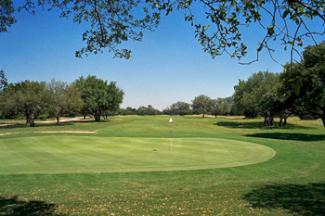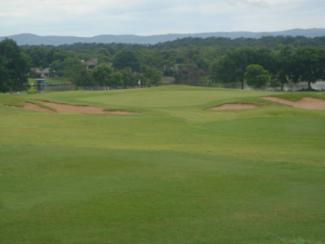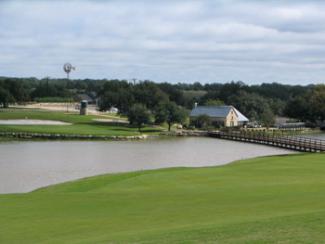Featured Golf News
Snowbirds find Great Golf in small Central Texas Towns
It begins when the weather turns raw and cold and the leaves start falling off the trees in the areas north of the Red River, which separate southern Oklahoma and northern Texas. A migration of massive proportions, made up of thousands of RVs and even more cars and trucks as "snowbirds" - those folks who leave their homes in Iowa and Minnesota and Kansas and Nebraska and even as far north as Alaska every winter to find three or four months of solace in warmer confines in the Lone Star State.
They come looking for golf that can't be played in places where the wind bites at skin and the ground is covered in snow and ice. Mostly over the age of 50, they invade Texas towns, assuring their hosts a huge economic benefit (even in these rough economic times) and a full tee sheet on days thin-blooded natives would rather stay indoors.
Some towns have staked out huge RV parks for these visitors, with some right next to golf courses offering season-long stay-and-play packages. Others have special hotel, motel or condo rates specifically for snowbirds, many of whom return to the same Texas towns year after year.
While there are many Texas towns that offer these benefits, we wanted to give late-comers a bit of a primer for those areas with the best of the golf offerings. The courses listed below are located in small towns - the largest of which is about 10,500 in population - west of Austin and north and west of San Antonio in Central Texas, a region that is varied in topography and not as far a journey as some of those in the southern part of the state. They are listed in a north-to-south configuration, just as a snowbird would find them on a drive away from the bad weather.

Delaware Springs
Delaware Springs takes Back Seat to no Course
Known for almost two decades as a friendly yet challenging course that boasts low prices, friendly service and a picturesque setting, Delaware Springs Golf Club in Burnet (pronounced "BURNit") can take its place among the best municipal courses in Texas.
Set in the seat of Burnet County in the heart of Texas and the famed Highland Lakes region, Delaware Springs opened in 1992. Architects Dave Axland and Dan Proctor fashioned a natural course that fits the terrain perfectly and plays 6,829 yards from tips. The course is nestled into rolling hills. Its oak-lined holes are frequently festooned with bunkers, large greens that slope severely and numerous chances to bump and run shots into the putting surfaces.
The designers added a few original touches, such as the descriptive Scottish names for each hole (the 18th is called "Hame" for the home hole). Partly as a reaction to the over-shaped courses of the 1980s, partly because of the underlying rock that prevented much digging and a modest budget, Axland and Proctor (who have worked with Ben Crenshaw and Bill Coore) built a low-profile course whose strength would rely on interesting greens that dictate the strategy off the tee. Eight of the holes have no bunkers, but because of the use of the existing contours as well as some key trees, a player is not aware of this while playing the course for the first time.
However, where bunkers are utilized, they are used to great effect, both artistically and strategically. On the 475-yard fourth hole there is a bunker smack in the middle of the fairway some 20 yards short of the green, a distance that grabs the player's attention when he has a wood or long-iron in his hands. The real beauty of the bunker, though, is that it distracts from the large greenside bunker to the left. A player focusing on just carrying the central bunker will often wind up in this left trap.
On two holes at Delaware Springs, the second (a 365-yard par-four) and sixth (a 490-yard par-five) the player is asked to play over a solitary tree in the fairway on his approach. At No. 2, the player has just a short-iron in, but it must be precise to hold the shallow green, and on the sixth, the greenside bunkering scheme on the front-right and left requires that a long second shot must be brought in from left to right, up the axis of the green between the bunkers. However, holding a 3-iron, the player will often just 'see' the tree in the fairway he must clear.
Another interesting design twist involves placing the signature hole as the opener. Playing 504 yards to a par-5, No. 1 is best attacked with an iron into the left side of a sloping, tree-lined fairway. The creek cuts into the landing area, making it a testy tee shot. The second shot must bend around the dogleg to the left and over the creek, and the approach is into a green shaded by large trees on the right.
For more information or a tee time, visit www.delawaresprings.com.

7th Green at Legends Golf Course
Legends Golf Course Meshes with Hill Country Topography
Playing a round of golf at this course is akin to teeing it up at a high-end, daily-fee track in Austin, Dallas and San Antonio, with a lot of the things that makes the Highland Lakes-area so special thrown in for good measure.
This jewel was designed by Champions Tour pro Tom Kite in conjunction with Austin-based architects Roy Bechtol and Randy Russell, and it shows the touches each man brought to the process. There is the pinpoint accuracy Kite is known for in his play and designs, and Bechtol and Russell added their moxie with the combination of lengthy and short holes, risk-reward opportunities and attention to detail both on and around the course.
Located in the Llano County burg of Kingsland and nestled in a bend of the Colorado River arm of Lake LBJ, Legends offers solitude and elegance along with a suitable challenge for scratch golfers. It stretches 7,260 yards from the tips yet is forgiving enough for beginners. The Legends, because of its circular layout, offers both links-style and Hill Country golf at its finest.
The final three holes on the front side offers the best the Legends has to offer. No. 7 is one of two signature holes, and at 480 yards from the back tees is one of the longest par-4s in the area. A dogleg-left that heads downhill and requires a blind tee shot out toward the trees that guard Lake LBJ, you have to trust your swing and let it fly to have a chance at the green in two. The second shot plays to a green that sports several shelves that affect putting; this is a true test for golfers of all skills.
Next up is the par-3 eighth. The entire right side of the hole's 186 yards is bordered by Lake LBJ, and the green seemingly sits on a little bluff above the lake. A large bunker flanks the right side of the green, and when the pin is back right, you need to play to the middle.
The front nine ends with a tree-lined 452-yard par-4 with a tight fairway and some of the most punitive rough on the course. The slight right-dogleg favors a right-to-left shot off the tee to open the green to a relatively easy approach.
Then there is No. 15 is a devilishly long (253-yard!) par-3 guarded by sand on its entire left side. The yardage guide says the hole plays longer than its yardage - how can that be? - with a green that slopes from back to front.
The round ends at a 548-yard par-5 18th, where trouble lurks along the entire right side of this narrow dogleg-right hole, and second shots should stay left to avoid fairway bunkers right. The triangle-shaped green is bordered by another bunker short and right and slopes back to front.
For more information or a tee time, visit www.legendsgolftx.net.

The Approach to the 18th Green at Vaaler Creek
Vaaler Creek is Newest Small-town Draw in Hill Country
About an hour west of Austin in the town of Blanco (population 1,505), Vaaler Creek Golf Club opened nine new holes on July 4, 2009, completing the venue that originated with nine holes two years prior.
Vaaler Creek, the centerpiece of the Rockin J Ranch Development south of Blanco and about 40 minutes north of San Antonio, was designed by Michael Lowry and J.R. Newman. The track features well-placed bunkers and beautiful water features. It also boasts spectacular panoramas of the Hill Country, an abundance of live oaks and a constantly rolling topography.
The new nine is now plays as the front; it's considerably shorter (3,343 yards) than Vaaler Creek's more established back nine (3,521). The new holes' real defense is its greens, which demand you play to the correct location to have any chance to score. Despite playing just 6,864, the course carries a rating of 73.0 and a slope of 140 from the tips.
Each hole is a different challenge at Vaaler Creek. Players won't soon forget the 195-yard par-3 12th that features a pond surrounding the green on three sides. The 511 yard par-5 10th gives players a choice off the tee of upper and lower fairways, with substantially different elevations and approach options.
With plenty of greenside bunkers, man-made and natural waterways and elevation changes, this course looks like a terrific challenge. But players will also find the track extremely playable and fair.
For more information or a tee time, visit www.vaalercreekgolfclub.com.
Steve Habel is one of Cybergolf's national correspondents, contributing news stories, features, equipment and book reviews and personality profiles from his base in Central Texas. He is also the managing editor for Business District magazine in Austin and works as a contributing editor for Horns Illustrated magazine, a publication focusing on University of Texas sports. He also writes a blog (www.shotoverthegreen.blogspot.com), which features news on golf and the Longhorns.
Story Options
 |
Print this Story |
